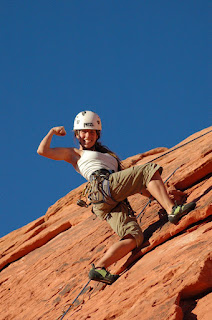
Red Rocks was a blast! After being humbled by Yosemite's long trad* routes, it was fun to hop on some sport routes in Red Rocks. Three friends from the gym back home came out to climb with me for 5 days (2 days in JTree and 3 in Red Rocks)! We had a blast camping, climbing, and riding around in their rented red Mustang convertible (go figure- it was the cheapest rental car they could find!)
 Highlights included running into other Outward Bound folks, campfires with the Spaniards camping "next door," climbing with Bob (local Solid Rock climber), encouraging all three friends as they gained comfort with leading* and cleaning routes outside, chats with Brian, prayer/worship times with Gretchen, and running the 13-mile Red Rock Canyon scenic loop with Cole.
Highlights included running into other Outward Bound folks, campfires with the Spaniards camping "next door," climbing with Bob (local Solid Rock climber), encouraging all three friends as they gained comfort with leading* and cleaning routes outside, chats with Brian, prayer/worship times with Gretchen, and running the 13-mile Red Rock Canyon scenic loop with Cole.
I look forward to going back to Red Rocks for more sport climbing, and to do some of the stellar multi-pitch* trad routes that I have heard so much about. However, it won't be quite the same without the company of friends from home.

*CLIMBING TERMINOLOGY IN BRIEF:
-The belayer is the person who uses a friction device to hold onto the other end of the rope in case the climber falls.
-The leader starts with the rope at the bottom of the climb and clips it into protection she (or he) places as she climbs. Lead climbing is different from Top-roping in that one does not set up an anchor at the top of the climb before climbing (Like you might see in a gym.)
-Trad is short for traditional climbing which requires equipment (or "pro," short for protection) to place in cracks in the rock and clip a rope into as one climbs up, in order to protect a fall.
-Sport climbing refers to climbs where permanent bolts have been placed in the rock by climbers to clip their rope into for protection. Red Rocks has both sport and Trad routes, but Yosemite is famous for it's long, "sandbagged" trad routes. Sandbagged means that the route is probably harder than its published rating.
-Cleaning a route refers to the process of following the climb to take out the protection that the leader placed and/or clean the anchor at the top of the climb.
-Multi-pitch climbs are more than a single rope length, so they are split in to sections where the leader climbs the first pitch, belays the second (who cleans the gear) up to the anchor, then leads up the next pitch, belays the second up to the next anchor, and so on...
